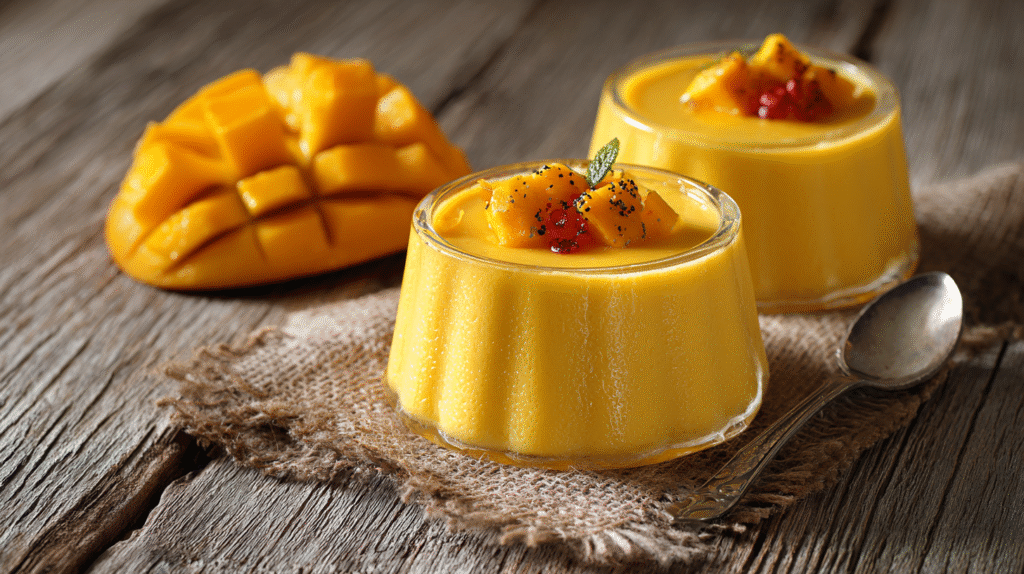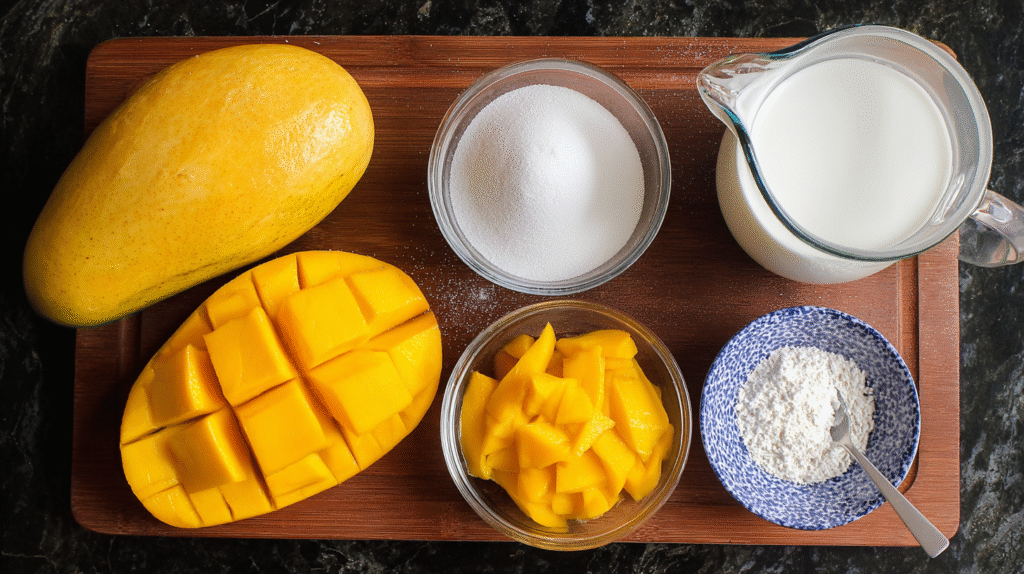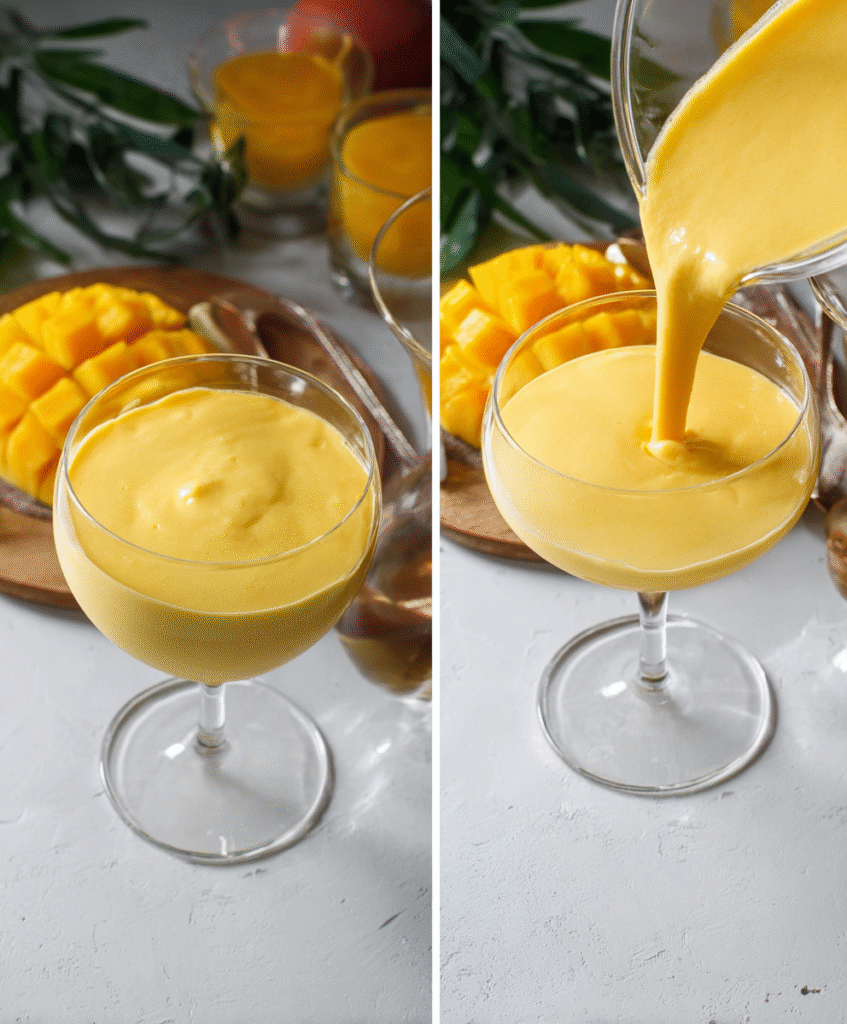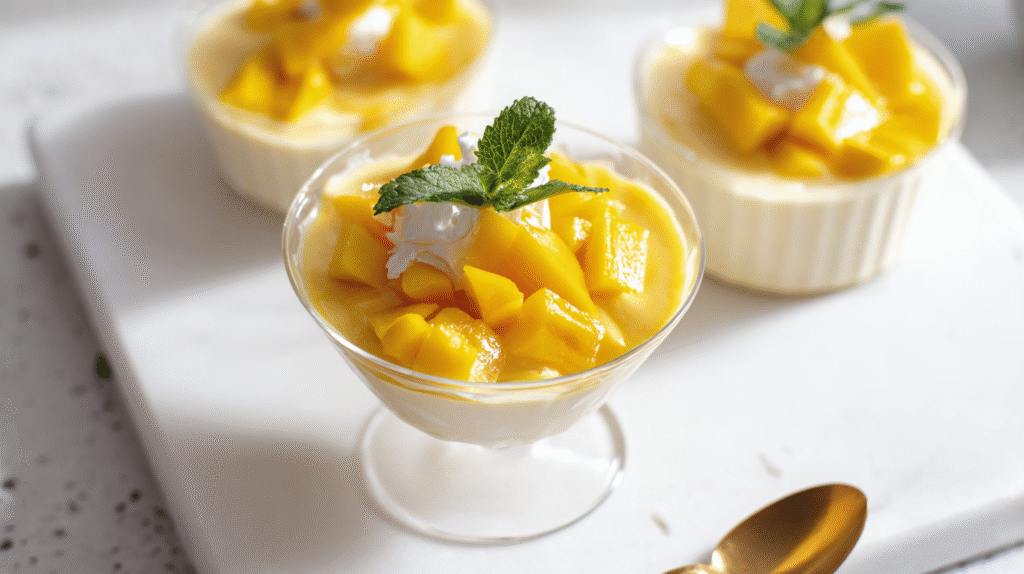If there’s one dessert that captures the magic of a summer afternoon and the charm of Asian flavors, it’s this mango pudding recipe. Light yet luxurious, it melts on your tongue with its creamy texture and bright tropical taste. Whether you’re a fan of dim sum classics or seeking a refreshing vegan treat, this guide offers the most complete mango pudding recipe online today. You’ll find everything you need to know—simple steps, ingredient comparisons, vegan swaps, and pro tips—all crafted to help you succeed in your kitchen. Let’s dive into the best mango pudding recipe you’ll ever need.


Mango Pudding Recipe – Creamy, Fresh & Vegan Options You’ll Love
- Total Time: 2 hours 20 minutes
- Yield: 4 servings 1x
Description
Easy, creamy mango pudding with both traditional and vegan versions. Silky, tropical, and no-bake!
Ingredients
2 ripe mangoes or 1 cup canned mango pulp
1 tbsp unflavored gelatin OR 1.5 tsp agar agar
1/2 cup condensed milk or coconut milk
2 tbsp sugar or maple syrup
1/4 cup hot water for blooming (gelatin only)
Optional: 1/4 cup nata de coco, cream for topping
Instructions
1. Blend mango into a smooth puree and strain.
2. For classic: bloom gelatin in hot water. For vegan: boil agar with mixture.
3. Warm mango with milk and sugar. Add thickener.
4. Pour into molds. Add nata de coco if desired.
5. Refrigerate for 2–4 hours until set. Serve chilled.
Notes
Use fresh mango for brighter flavor.
Adjust sugar based on mango sweetness.
Do not boil gelatin or it won’t set properly.
Chill overnight for firmer texture.
- Prep Time: 10 minutes
- Cook Time: 10 minutes
- Category: dessert
- Method: no-bake
- Cuisine: Asian
Nutrition
- Serving Size: 1 ramekin
- Calories: 210
- Sugar: 18g
- Sodium: 45mg
- Fat: 8g
- Saturated Fat: 6g
- Unsaturated Fat: 2g
- Trans Fat: 0g
- Carbohydrates: 30g
- Fiber: 2g
- Protein: 3g
- Cholesterol: 5mg
Keywords: mango pudding, mango pudding recipe, vegan mango pudding, creamy mango dessert, mango coconut milk pudding
From Dim Sum to My Dessert Table: A Mango Pudding Memory
When I first tasted mango pudding at a tiny Hong Kong dim sum spot, it wasn’t just a dessert—it was a memory. The silky texture, the intense mango flavor, and the chill from the fridge felt like sunshine and celebration in every spoonful. Years later, when I began recreating comfort recipes for my blog Recent Recipe, this mango pudding recipe had to be one of them. My mission has always been to simplify recipes without compromising their soul—and this creamy mango dessert does just that. It blends ease with elegance, culture with convenience. This dessert became one of my family’s favorites, and soon, friends were asking for it at every gathering.
Why This Mango Pudding Recipe Beats the Rest
There are countless versions of mango pudding online, but few combine both traditional and vegan methods in one reliable guide. This mango pudding recipe includes both a classic Hong Kong-style version and a dairy-free, no gelatin mango pudding variation using coconut milk and agar agar. What makes it stand out?
- It uses everyday ingredients like ripe mangoes, condensed milk, and coconut milk for maximum flavor.
- It walks you through every technique, from blooming gelatin to setting agar properly.
- It avoids the common pitfalls—like grainy textures or watery results—by sharing clear steps and expert-level tips.
You can easily tailor this homemade mango pudding recipe to your diet or taste preferences. Want something extra creamy? Use evaporated milk. Need it plant-based? Go with full-fat coconut milk. Prefer something fun? Transform it into a mango sago dessert by adding soft, chewy tapioca pearls for extra texture and fun. The options are as fresh and flexible as the fruit itself.
And if you love desserts like this, you might also enjoy similar creamy creations in our dessert, breakfast, and even lunch sections. We believe that any time of day is perfect for pudding.
Ingredients You’ll Need (Classic & Vegan Mango Pudding Compared)
When creating the perfect mango pudding recipe, your choice of ingredients plays a major role in flavor, texture, and dietary fit. Below is a quick comparison of what you’ll need for each version:

| Classic Mango Pudding | Vegan Mango Pudding |
|---|---|
| Fresh mangoes or canned mango pulp | Fresh mangoes or canned mango pulp |
| Unflavored gelatin | Agar agar powder |
| Condensed milk or evaporated milk | Full-fat coconut milk |
| Granulated sugar | Maple syrup or cane sugar |
| Heavy cream (optional) | Coconut cream (optional) |
Fresh mango pudding tastes best when made with ripe Ataulfo or honey mangoes, but canned mango pulp works great too, especially for consistent texture in Chinese mango pudding.
Step-by-Step Instructions + Expert Tips
Here’s how to make both the classic and vegan mango pudding recipes, step by step. These versions are kitchen-tested for reliability and flavor.
Classic Mango Pudding Recipe
Ingredients:
- 2 ripe mangoes (or 1 cup mango puree)
- 1 tablespoon unflavored gelatin
- 1/4 cup hot water (for blooming)
- 1/2 cup condensed milk
- 1/2 cup whole milk or evaporated milk
- 2 tablespoons sugar (adjust to taste)
- Optional: 2 tablespoons heavy cream
Instructions:
- Peel and chop mangoes, blend until smooth. Strain through a sieve for silkiness.
- Bloom gelatin: sprinkle it over hot water, let it sit 5 minutes until soft.
- Warm mango puree slightly. Add sugar and stir to dissolve.
- Mix in bloomed gelatin until fully melted. Do not boil.
- Stir in condensed milk, regular milk, and cream.
- Pour into molds or cups. Refrigerate 4–6 hours until set.

Pro Tip: Avoid adding gelatin to boiling liquid, as high heat will prevent it from setting properly.
Vegan Mango Pudding Recipe (No Gelatin)
Ingredients:
- 1 cup mango puree
- 1/2 cup full-fat coconut milk
- 1.5 tsp agar agar powder
- 2 tbsp maple syrup or cane sugar
- Optional: 1/4 cup nata de coco (coconut jelly)
Instructions:
- In a saucepan, combine mango puree, coconut milk, agar powder, and sugar, whisking until smooth.
- Bring to a boil over medium heat. Stir constantly for 2 minutes.
- Reduce heat and simmer until agar dissolves completely.
- Pour into cups. Add nata de coco halfway if using.
- Chill for 2 hours or until firm.
Pro Tip: Unlike gelatin, agar must be boiled to activate. If your vegan mango pudding isn’t setting, it likely wasn’t heated enough.
This creamy mango dessert works beautifully for dim sum nights or as a tropical finish to dinner with family and friends. If you’re looking for no gelatin mango pudding options, this plant-based version is ideal for you.
Fresh, Frozen, or Canned Mango – Which Is Best?
The base of any good mango pudding recipe is, of course, mango. But not all mangoes are created equal—especially when it comes to texture and sweetness. Whether you’re preparing a creamy mango dessert or a vegan mango pudding, your fruit choice matters more than you think.
Fresh mangoes offer the most vibrant taste and aroma. Ataulfo and honey mangoes are ideal due to their natural sweetness and minimal fibers. However, using fresh mangoes requires peeling, slicing, and blending, which might not be ideal when you’re short on time.
Canned mango pulp, especially Alphonso, is the go-to for consistent texture and color. It’s the secret behind many authentic Chinese mango pudding recipes served in dim sum restaurants. It blends smoother, sets better, and removes the guesswork from ripeness.
Frozen mango chunks can be a backup if fresh mangoes aren’t in season. Just thaw them completely before blending. They work best for homemade mango pudding but may dilute the flavor slightly.
For health-conscious cooks, here’s a quick nutrient snapshot based on USDA data:
- Fresh mangoes: high in Vitamin C, fiber
- Canned mango pulp: higher in sugar
- Frozen mango: preserves most nutrients but may retain extra water
Pro tip: If using frozen or canned fruit, reduce added sugar to avoid overly sweet results. For more nutritional insights on mangoes, you can visit Healthline’s mango nutrition guide.
Gelatin vs. Agar: What Sets Best?
One of the most critical decisions in a mango pudding recipe is your choice of thickener. Should you go with classic gelatin or opt for agar agar for a vegan mango pudding?
Here’s a clear side-by-side comparison:
| Gelatin | Agar Agar |
|---|---|
| Derived from animal collagen | Plant-based (seaweed) |
| Needs to be bloomed in warm water | Must be boiled to activate |
| Creates a creamy, jiggly texture | Firmer, jelly-like set |
| Cannot be frozen | Can be frozen, but texture changes |
| Best for traditional pudding texture | Perfect for vegan mango pudding |
Many cooks ruin their pudding by treating agar like gelatin or vice versa. The key is to understand their activation requirements. Blooming gelatin in cold water avoids lumps, while agar only sets if brought to a rolling boil. That’s why your pudding may not firm up—it wasn’t heated right.
Want the best of both worlds? Some home chefs blend gelatin for body and agar for stability. But we suggest mastering one at a time for foolproof results.
For those interested in creamy alternatives, explore our breakfast or dessert pages to discover how other puddings benefit from coconut milk and agar fusion.
How to Serve Mango Pudding Like a Pro

Once your mango pudding recipe is fully set, it’s time to enjoy and impress. Whether you’re serving a creamy mango dessert at a summer dinner party or preparing a refreshing lunch finale, presentation elevates the experience.
For the classic look, use glass ramekins or silicone molds to create smooth, rounded shapes. To unmold, briefly dip the bottom in warm water, then carefully invert it onto a chilled plate. A swirl of whipped cream, a few fresh mango chunks, or even nata de coco cubes on top add flavor and texture.
For a tropical twist, serve your mango pudding with coconut cream drizzle, or layer it into mini trifles with cake crumbs and berries. Hosting a dim sum night? Serve this alongside our other Asian-inspired dinner ideas for a full experience.
Looking for something playful? Add cooked tapioca pearls to turn it into a mango sago dessert, or swirl in mango puree for a marbled look. Kids love it. Adults can’t resist it. And the no-bake aspect makes it ideal for busy days.
Storage, Freezing & Make-Ahead Tips
This mango pudding recipe stores beautifully and works great for prepping ahead.
Refrigerator:
Keep the pudding covered in the fridge for up to 3–4 days. Cover with airtight containers or plastic wrap to keep out fridge odors. After 24 hours, the texture becomes firmer and the flavors more pronounced.
Freezing (caution):
If using gelatin, freezing is not advised. The structure breaks down and becomes watery when thawed. However, agar-based vegan mango pudding can be frozen for up to 2 weeks, but expect a denser texture after thawing.
Make-ahead:
Prepare the pudding the day before a party or gathering. If you’re using decorative molds, unmold and plate it just before serving to maintain shine and shape.
For longer-lasting creamy desserts and ideas, be sure to browse our lunch and dessert collections where similar no-bake options shine in both taste and convenience.
Table of contents
Table of Contents
What are the ingredients of mango pudding?
The base ingredients are mango puree, a setting agent (gelatin or agar agar), sweetened milk (condensed or coconut), and sugar. Some versions add cream, nata de coco, or vanilla.
What are the 4 ingredients in milk pudding?
Traditional milk pudding includes milk, sugar, gelatin (or agar), and flavoring such as vanilla or fruit puree. Our mango pudding recipe adds mango for extra flavor.
How to make pudding step by step?
Blend mangoes into a puree. Heat with milk and sugar. Add the thickener—either bloomed gelatin or dissolved agar. Stir until combined. Pour into molds and chill until set.
What country is mango pudding from?
Mango pudding is a beloved dessert in Hong Kong and a staple on the menu at Chinese restaurants across the globe. It has also become a favorite across Southeast Asia, especially in Thai and Filipino cuisines.
Conclusion
Whether you’re craving a silky Hong Kong-style mango pudding or a bright and creamy vegan mango dessert, this is the only mango pudding recipe you’ll ever need. It’s easy, versatile, and absolutely foolproof. After one taste, you’ll find yourself wanting to make it again and again. Don’t forget to bookmark, share, and explore our full dessert archive for more no-bake inspiration!







